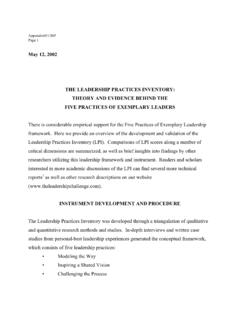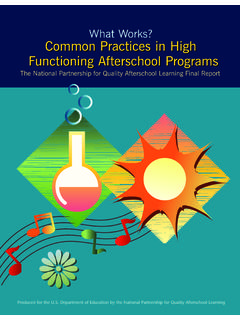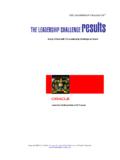Transcription of The Role of Leadership in the Promotion of …
1 The Role of Leadership in the Promotion of Knowledge Management in Schools Michael Fullan Ontario Institute for Studies in Education University of Toronto OECD Conference, March 18-19, 2002. Despite being in the learning business, schools and local education authorities (LEAs) are notoriously poor knowledge sharers. There are structural and normative reasons for this, built-in to the history and evolution of schools. Structural in that teachers have little time in the course of the day to get together to share ideas and refine their teaching. Normatively because teachers do not have habits of giving and receiving information. Indeed in many cases, the cultures of schools discourage such sharing ( , I don't want to blow my own horn; who does she think she is; others won't be interested in what I am doing etc.). In this paper, I make the case that the teaching profession, if it is to come of age, must be seen and experienced as an intellectual as well as a moral profession.
2 Because the intellectual or scientific basis of teaching has been underdeveloped I spend most of the time focussing on the knowledge- sharing aspect of schools and LEAs. In the final two sections of the paper, I take up the questions of moral purpose and knowledge sharing, and Leadership and sustainability. Knowledge Building The cover story in the business section of the October 30 Toronto Globe and Mail was titled Knowledge Officer Aims to Spread the Word (2000). In its profile of Rod McKay, international chief knowledge officer at KPMG, the article said, McKay's challenge is to get KPMG's 107,000 employees at all levels worldwide to share information (p. M1). Knowledge-sharing, says McKay, is 1. a core value within KPMG. Every individual is assessed on their willingness to share their experience with others in the firm (p. M1). Knowledge building, knowledge sharing, knowledge creation, knowledge management.
3 Is this just another fad? New buzzwords for the millennium? They could easily become so unless we understand the role of knowledge in organizational performance and set up the corresponding mechanisms and practices that make knowledge sharing a cultural value. Information is machines. Knowledge is people. Information becomes knowledge only when it takes on a social life (Brown & Duguid, 2000_. By emphasizing the sheer quantity of information, the technocrats have it exactly wrong: if only we can provide greater access to more and more information for more and more individuals, we have it made. Instead what you get is information glut. Brown and Duguid (2002) establish the foundation for viewing knowledge as a social phenomenon: Knowledge lies less in its databases than in its people (p. 121). For all information's independence and extent, it is people, in their communities, organizations and institutions, who ultimately decide what it all means and why it matters (p.))
4 18). A viable system must embrace not just the technological system, but the social system the people, organizations, and institutions involved (p. 60). Knowledge is something we digest rather than merely hold. It entails the knower's understanding and some degree of commitment (p. 120). 2. If you remember one thing about information, it is that it only becomes valuable in a social context. Attending too closely to information overlooks the social context that helps people understand what that information might mean and why it matters (p. 5). [E]nvisioned change will not happen or will not be fruitful until people look beyond the simplicities of information and individuals to the complexities of learning, knowledge, judgement, communities, organizations, and institutions (p. 213). Incidentally, focusing on information rather than use is why sending individuals and even teams to external training by itself does not work.
5 Leading in a culture of change does not mean placing changed individuals into unchanged environments. Rather, change leaders work on changing the context, helping create new settings conducive to learning and sharing that learning. Most organizations have invested heavily in technology and possibly training, but hardly at all in knowledge sharing and creation. And when they do attempt to share and use new knowledge, they find it enormously difficult. Take the seemingly obvious notion of sharing best practices within an organization. Identifying the practices usually goes reasonably well, but when it comes to transferring and using the knowledge, the organization often flounders. Hewlett- Packard attempted to raise quality levels around the globe by identifying and circulating the best practices within the firm (Brown & Duguid, 2000, p. 123).
6 The effort became so frustrating that it prompted Lew Platt, Chairman of Hewlett-Packard, to wryly observe, if only we knew what we know at HP , (cited in Brown & Duguid, p. 123). 3. I will not draw on examples from the business literature to demonstrate the role of knowledge in successful businesses (see Fullan, 2001a). Suffice it to say that the more successful businesses (compared to schools and LEAs, for example). have named knowledge sharing as an explicit value (as in KPMG) and created corresponding mechanisms and incentives to engage in it. They have valued both the giving' and the receiving' of knowledge as critical to improvement. The following figure summarizes this paradigm. Responsibility Receiving Knowledge Giving Opportunity Figure 1: Knowledge-Sharing Paradigm Examples from Education It may seem that business organizations are paragons of knowledge creation and sharing, but it is likely that only a small minority are this good (and they don't necessarily sustain this level of goodness).
7 Many of the same companies appear in different books, so the list seems longer than it actually is. Still, I would say that although the average company is about as bad as the average school system, when it comes to knowledge sharing, the best companies are better than the best school systems. There are proportionately more of them, and they are working more diligently on the task. 4. To take up the question of schools and LEAs, recent examples of success do focus on knowledge sharing (although regrettably they do not use the language). At the school level the developing of Professional Learning Communities that result in teacher development and greater learning is a case in point. Newmann, King & Young (2000) provide a clear example. They find that school capacity' was critical and that it was a function of five components: individual teacher knowledge, skills and dispositions, professional learning community (across teachers), program coherence, technical resources, and principal Leadership .
8 In other words, the role of the principal is to cause' the previous four components to get better and better on a continuous basis. At the school level, there is no better example of information becoming knowledge through a social process than to observe Assessment Literacy' play itself out in a professional learning community. Assessment Literacy is the collective capacity of teachers and the principal to examine student performance data, make critical sense of it in the disaggregate, develop action plans based on the data, and to take action which is monitored (see Fullan, 2001b). At the LEA level, Elmore and Burney's (1999) case study of the turnaround in District 2 in New York City is a prime example of building a culture of knowledge sharing and action. We might as well be talking about Shell or Ford as Elmore and Burney describe the intervisitation strategy: Intervisitation and Peer Networks District 2 [has] a heavy reliance on peer networks and visits to other sites, inside and outside the district, designed to bring teachers and principals into contact with exemplary practices.
9 5. Intervisitation, as it is called in the district, and peer consultations are routine parts of the district's daily life. Teachers often visit other classrooms in conjunction with consultants' visits, either to observe one of their peers teaching a lesson or a consultant teaching a demonstration lesson. And groups of teachers often visit another school, inside or outside the district, in preparation for the development of a new set of instructional practices. Usually principals initiate these outside visits and travel with teachers. In addition, principals engage in intervisitations with peers in other schools. New principals are paired with buddies who are usually more senior administrators, and they often spend a day or two each month in their first two years in their buddy's school. Groups of teachers and principals working in district initiatives travel to other districts inside and outside the city to observe specific instructional practices.
10 And monthly districtwide principals' meetings are held on site in schools, and often principals observe individual teachers in their peers' schools as part of a structured agenda for discussing some aspect of instructional improvement. Principals are encouraged to use visits and peer advising as management strategies for teachers within their buildings. A principal who is having trouble getting a particular teacher engaged in improvement might be advised by the district staff to pair that teacher with another teacher in the building or another building in the district. And principals themselves might be encouraged to consult with other principals on specific areas where they are having difficulties. Intervisitations and peer advising as professional development activities tend to blend into the day-to-day management of the district. The district budgets resources to support about three hundred days of professional time to be allocated to intervisitation activities.














